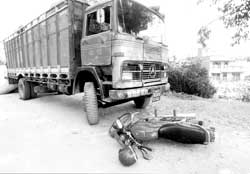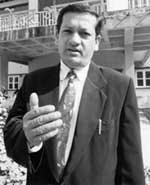 Nawaraj Timsina, from Siseri in Okhaldhunga had just paid his fare and was alighting from a microbus at the bustling Koteswor junction on morning a month ago. He climbed back on to say something to his aunt and uncle
Nawaraj Timsina, from Siseri in Okhaldhunga had just paid his fare and was alighting from a microbus at the bustling Koteswor junction on morning a month ago. He climbed back on to say something to his aunt and uncle who were also on board. He alighted again.
Bus driver Umanath Pudasaini, a Nuwakot resident, felt a bump beneath the wheels, and heard people shouting that someone had been run over. "I then drove off, dropped the rest of the passengers at Naya Baneswor and turned myself in at the police station in Gaushala," Pudasaini told us at the Hanuman Dhoka District Police Office.
Several eyewitness accounts in the next day\'s papers accused the driver of intentionally backing the bus to run over the wounded Timsina. Pudasini and other eye-witnesses say it was an accident. "I don't think it was intentional. The man fell. The driver panicked, backed agitatedly, running over the man by accident," says Raj Bikram Kathayan, who was at the site.
But the deceased man's family is determined to file a case of murder. "Several eyewitnesses have confirmed with the police that my nephew was run over intentionally," says Hem Prasad Timsina, Nawaraj's uncle who like many Nepalis believes that drivers intentionally kill wounded people they have run over so they don\'t have to pay hefty hospital bills and get away with only Rs 17,500 in funeral expenses and compensation.
However, the Vehicles and Transportation Act 2049 (1993) does not give any immunity to drivers who run over and kill people on the street. In fact, nowhere does the act mention that drivers can get away with just paying the oft-quoted Rs 17,500. "It does mention third party insurance, which many police, lawyers, and concerned professionals are not aware of," says advocate Lav Kumar Mainali.
Article 163 of the Act, which deals with the Payment of Medical and Obsequies Expenses and Compensation, says: "If any loss or damage is caused to any person from vehicle accident, the driver or owner or manager of vehicle shall be ordered to pay to the victim the following amount as medical expenses and compensation: In case of death of a person, the heir of the deceased person shall be paid with ten thousand rupees as obsequies expenses and as compensation, the amount equivalent to Third Party Insurance payable for such death according to this Act, if no Third Party Insurance has been procured.
According to Clause 55 of the newer Vehicles and Transport Regulations 2055 (1998), the owner or manager of the vehicle shall procure Third Party Insurance equivalent to Rs 300,000. "The law does make provision for compensation beyond Rs 17,500 and the kin of the deceased has a legal right to claim it, but many people are not aware of this," says Mainali.
So ,if Rs 10,000 is for obsequies expenses, where did the additional figure of Rs 7500 come from? "From what I understand," says Mainali, "this became an accepted practice after the courts, in the absence of the Vehicles and Transport Regulations (which appeared almost six years after the Act), sought the advice of insurance companies regarding Third Party Insurance. They made a rough estimate and came up with the figure of Rs 7,500. That's been the practice so far."
Although it is not mentioned anywhere in the Act or the Regulations that the family of a person who dies in a traffic accident should receive compensation equivalent to Rs 17,500, the general public, and authorities and professionals concerned labour under this misconception. "It is a misinterpretation of the law," says SSP Keshav Prasad Baral of the Valley Traffic Police. He finds it hard to believe that drivers intentionally kill people to avoid paying larger amounts of money.
 Investigations by the department have never come across evidence that this happens and Baral does not know of any case of a driver intentionally running over a person filed in court. "To my knowledge," adds Mainali, "cases of negligence, and reckless driving do occur. But in my career as a public prosecutor and defence lawyer dealing with such cases, I've never known anyone being charged with running over someone intentionally."
Investigations by the department have never come across evidence that this happens and Baral does not know of any case of a driver intentionally running over a person filed in court. "To my knowledge," adds Mainali, "cases of negligence, and reckless driving do occur. But in my career as a public prosecutor and defence lawyer dealing with such cases, I've never known anyone being charged with running over someone intentionally." Granted, says SSP Baral, the current law is largely in the interest of powerful transport lobby and not in the interest of the public. But that in itself is a reason why drivers don't have to run over people to avoid paying expensive medical bills. "The present Vehicles and Transport Act (amended in 2049 after the transport lobby went on strike) offers plenty of immunity to drivers, who are also protected by influential welfare associations and organisations," says Baral.
The Vehicles and Transport Act 2049 requires vehicle owners to procure third party insurance. But, says Mainali, "Apart from long haul passenger vehicles, like night buses, who have begun to do so, most vehicle owners don't." The problem with implementation and deciding what the letter and spirit of the law mean goes further, explains the lawyer. "The Department of Transport doesn't withhold a road permit to vehicles that do not have this insurance."
According to the Act, it is largely vehicle owners and managers who are required to pay the fines and fees in case of an accident, not the driver. Accidents may occur owing to negligence, but intentionally running down someone is equivalent to murder and would be tried under the stricter civil Codes. "Who would want to risk life imprisonment or harsher punishment?" asks a police officer.
The Vehicles and Transportation Act itself has provisions for homicide-driving with the intention of killing, reckless driving with no intention to kill, and accidents not the result of rash driving. The penalty ranges from life imprisonment and confiscation of property to a Rs 500 fine and two years imprisonment.
Still, almost every time there is an accident the local media dutifully reports that it was a case of drivers intentionally running over wounded victims. It happened to Timisina in Koteswor, in Tulsipur two months ago, to a woman scooter driver earlier this year.
"There may be some incompetence on our part during investigations, but I just don't see it happening. It is more a composite effect of a lack of education, enforcement, and engineering," says another police officer. He thinks lack of sidewalks, jay-walking, speeding, dark streets are what cause deaths on the streets, and 90 percent of traffic deaths in Nepal involve pedestrians.


